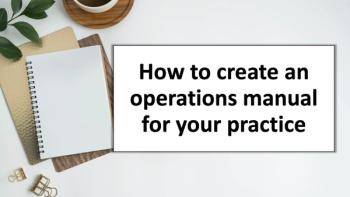
Unclog Telephone Bottlenecks
How to improve phone flow
Do patients, referring physicians, laboratories, and pharmacists ever tell you what a pain it is to call your practice? The phone is your practice's lifeline -- but if yours is like many offices, it's likely an area that could use some improvement.
Before you add more telephone lines, hire more staff to answer telephones, or leap into expensive new technology, take a look at your administrative processes. Maybe it is how you are scheduling appointments, renewing prescriptions, handling referrals, or other activities that are causing the telephone bottlenecks in your practice.
Look for clues to revising or eliminating the processes that influence the number of incoming and outgoing telephone calls by:
- Tracking the number of incoming calls by hour, day, and topic,
- Noting the number of repeat calls to your practice,
- Logging outbound calls,
- Performing a "mystery caller"
survey, - Analyzing the telephone system's strengths and weaknesses, and
- Uncovering any administrative processes that increase the amount of time you, your staff, and your patients spend on the telephone.
Track incoming calls
Many telephone systems feature software modules that automatically track and report the number of calls per day and hour, the duration of the calls, how long callers spend on hold, and so on. You'll need to track this information to diagnose what ails your phone system, so if your system cannot track these items automatically, have your staff to do so manually.
But even a telephone system with sophisticated reporting software won't tell you why patients call. Give a tracking log to all staff who handle inbound patient calls. The log should allow them to quickly check off common topics. Gather information about inbound calls only at the point of the patient's first live telephone contact with staff.
Your tracking report -- whether manual or automatic -- should show the number of incoming calls within each hour block for at least five consecutive days. Remind staff several times a day to keep filling out the log. Although it takes a bit of extra effort on their part, in the long run it will help make their jobs easier. It may take a couple of attempts to get a complete enough record to be able to see trends and find trouble spots.
The results of this exercise may show you, for example, that 30 percent of your incoming calls are about laboratory results, 10 percent are for prescription refills, and 5 percent are for directions to your new satellite clinic.
You are not looking for statistical perfection, but it's important that you do not underestimate the volume of inbound calls or miss an important category.
Record repeats
Your inbound call tracking form should note repeat calls -- when someone has called your practice one or more times without getting his or her question resolved. For example, a patient calls at 8 a.m., leaves a message, then calls back at 10 a.m., 2 p.m., and maybe again later until they get their question answered.
Ask your call trackers to make a special mark in the appropriate box of the log whenever patients say that they have already called about an issue. Then calculate the percentage of total calls that were repeat calls. It is not uncommon for as many as a third of incoming calls to be repeat calls. Also calculate the percentage of repeats within each topic area to spot weaknesses in communication links with patients.
Once you have the data, look for what's causing the repeat calls. Sometimes these are just your most impatient patients. More often it's because a physician or nurse is telling patients to call back the next day for test results when the results and processing take longer.
Or you may find that patients are calling you, not their pharmacy, to make routine prescription refill requests. Letting clinical and prescription refill calls go unanswered until the end of the day will boost the number of repeat calls, which take up staff time and create patient frustration -- even anger.
Analyze outbound calls
Outbound calls also are good indicators of the inefficiencies that waste staff and providers' time. Track outbound calls using a form similar to the one for inbound calls. Be sure to conduct the inbound and outbound surveys during different weeks so that staff won't get confused.
Target an area for improvement when the percentages of inbound and outbound calls seem to match. For example, a high volume of inbound and outbound calls dealing with test results may indicate that your staff and patients spend too much time playing telephone tag.
Do you have a protocol that sets expectations for the timing of getting the results to patients? Is it realistic? Does anybody follow up to make sure that protocol works? Maybe there are other ways to communicate test results to some patients. Could you send a confidential letter to the patient? Or would your telephone system allow you to set up individual, temporary, password-controlled voice-mail boxes for patients to call when they expect test results?
Mystery patient survey
Supplement your analyses of inbound and outbound call data with a mystery patient survey. The survey can reveal what patients or referring physicians encounter when they call your practice.
Ask a friend to call your practice several times during the week and write down how often they got busy signals, how long they waited on hold, what they heard while on hold, and their impressions of the staff's telephone manners. Your practice's administrator may be able to exchange mystery caller survey tasks with a colleague at another (noncompeting) practice.
The mystery caller should try to call in during every hour of the day and each time ask one simple question, such as:
- How do I get to your office?
- Can you tell me something about
Dr. __________________? - Do you accept _________________ insurance?
- When can I get an appointment for a physical with Dr. _______________?
You may be surprised -- not always pleasantly -- by what happens when people call your practice during the lunch hour, immediately after the practice opens in the morning, or just before closing. Of course, you should keep this portion of your telephone analysis secret until it is completed.
Change processes
Modifying internal processes -- including those that at first blush don't seem related to the telephone -- can reduce the volume of incoming and outgoing telephone calls. Think about the following activities and how you might do them differently.
Refills -- Ask patients to call their pharmacies for refills, and ask pharmacists to fax approval requests to you. Establish a secure electronic interface with local pharmacies or use the automated prescription software that many large drug store chains offer.
If you use a voice-mail box to prompt callers to leave refill requests and questions, make sure your staff handles those requests and questions promptly. Be sure to ask patients whether they need refills during office visits or make it part of the rooming process. Finally, make sure the prescription is written legibly so the pharmacist doesn't have to call you to clarify the medication, dosage, or your instructions.
Billing -- Reduce calls about billing questions by revising your billing statements if they are unclear. Statements should show clearly what amount is owed, by whom, for what service from what doctor, and when any payment is due. Seek advice from a small group of patients, or ask your neighbor if they can understand your statement. Don't clutter up the statement with billing acronyms or medical jargon.
Give the billing department its own telephone number and print it on billing statements so patients can call directly when they have questions. An e-mail account (for example,
Anticipate requests -- Send a "welcome to our practice" packet to all new patients before their first appointment. Make sure your practice's brochure and Web site describe hours of operation, physicians, financial policies, locations, directions, services, and other issues that new patients are likely to call about.
Callbacks -- Set a two-hour time limit for returning calls to patients, referring physicians, and others. If you cannot resolve a patient's question within two hours, call the patient with a status update.
Scheduling -- Avoid unnecessary callbacks to patients by empowering staff to handle more patient scheduling duties. You can train triage nurses to schedule appointments; allow checkout staff to schedule follow-up visits; and allow staff to schedule appointments without always checking first with the physician.
Promote your providers -- Remind patients that your nurse or assistant is an important member of the care team and can handle many questions. Have individual business cards printed for each of your assistants. It's a small investment that creates greater credibility and better patient access to advice.
Follow-up calls -- Call patients after a procedure to review medical instructions, evaluate the patient's improvement, adjust medications if appropriate, and reinforce discharge instructions. A proactive approach to answering questions also reduces the likelihood of future telephone calls and helps patients get better faster.
Test results -- Stop asking all patients to call in for test results. Likewise, make sure yours is not one of those practices that never tells patients when to expect test results -- this will spur many patients to call your office. Ask patients how they want to be informed of normal test results, such as voice mail, e-mail, letter, and so forth. Don't leave test results in a voice-mail box or e-mail unless you have written permission to do so and the results are normal. If you mail test results, include sufficient information about what the results mean to try to head off patient questions.
The technology solution
Maybe a new telephone system really is the answer. A 10-physician surgery group I visited recently found that its aging telephone system could not be adapted to offer voice mail, selective paging, hands-free conferencing, or other options. A new system greatly reduced the demands on the switchboard staff because callers could quickly navigate their way to the proper staff members without requiring the live operator's assistance.
Other options include:
Voice mail -- Use it for billing, physician referrals, or prescription refills -- but never to triage clinical calls. Always offer a "live" operator option; check voice-mail boxes frequently; and require staff to return calls promptly.
Auto attendants -- Always begin the message stating where to call in an emergency. Give callers an option to speak to a live operator, and never list more than five options.
Automatic call distributors -- If you use a system that automatically routes unanswered calls to other extensions after a set number of rings at the main number, make sure that the staff who receive the overflow calls know what to do.
Electronic medical record -- An EMR can reduce the number of times that callers -- whether patients or referring practices -- are transferred or wait on hold by allowing staff to more quickly locate patient charts, test results, and other information.
Need more staff?
OK, maybe you do need more staff to handle the telephones. Telephone operators whose duties are to accept calls, record information about the caller's needs, and route the messages or the callers can respond to 300 to 500 phone calls per day. If the operator just routes calls, the productivity increases to 1,000 to 1,200 calls per day. The average triage nurse can respond to 65 to 80 calls a day, but that depends on how the nurse is instructed to handle the calls, whether the practice has an EMR, and other factors.
Another way to look at potential call volume is by specialty. A primary-care practice will receive about 100 to 200 calls per physician per day; a specialist, 75 to 125 calls per physician per day.
Your call volume may fall out of these ranges depending on the maturity of your practice, the needs of your patients, and your practice's success in managing phone demand. Don't ever take benchmarks at pure face value -- if an operator must walk from his or her desk to deliver every message to the nurses' station, for example, then adjust the benchmark accordingly.
Look at ways to redesign patient flow processes so that demand for the telephone is reduced. Demands that cannot be eliminated can at least be shifted to the most appropriate stage of the patient flow process and to the most appropriate person. For example, figure out how to get calls from patients with clinical questions directly to the triage nurse.
The telephone is your practice's front door. Without it, patients don't get scheduled, referrals are not made or received, patient triage is delayed or doesn't happen, patients' after-hours questions don't get handled, prescriptions don't get renewed, and claims can't be followed up. So don't let an inadequate telephone system, clumsy internal procedures -- or both -- make it hard for your patients to get through that "other" front door of your practice.
Elizabeth Woodcock is director of knowledge management for Physicians Practice. She can be reached at
This article originally appeared in the February 2004 issue of Physicians Practice.
Newsletter
Optimize your practice with the Physicians Practice newsletter, offering management pearls, leadership tips, and business strategies tailored for practice administrators and physicians of any specialty.









